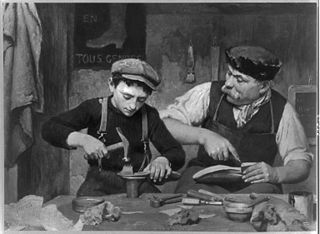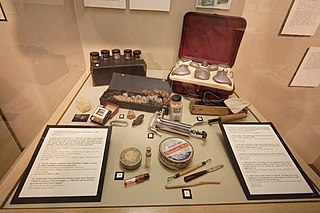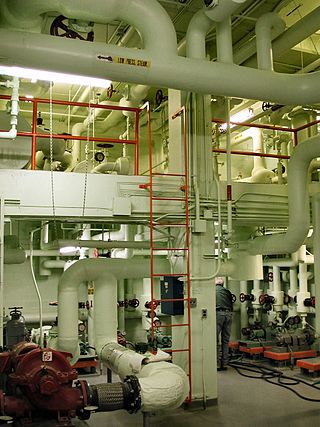
Apprenticeship is a system for training a new generation of practitioners of a trade or profession with on-the-job training and often some accompanying study. Apprenticeships can also enable practitioners to gain a license to practice in a regulated occupation. Most of their training is done while working for an employer who helps the apprentices learn their trade or profession, in exchange for their continued labor for an agreed period after they have achieved measurable competencies.

Carpentry is a skilled trade and a craft in which the primary work performed is the cutting, shaping and installation of building materials during the construction of buildings, ships, timber bridges, concrete formwork, etc. Carpenters traditionally worked with natural wood and did rougher work such as framing, but today many other materials are also used and sometimes the finer trades of cabinetmaking and furniture building are considered carpentry. In the United States, 98.5% of carpenters are male, and it was the fourth most male-dominated occupation in the country in 1999. In 2006 in the United States, there were about 1.5 million carpentry positions. Carpenters are usually the first tradesmen on a job and the last to leave. Carpenters normally framed post-and-beam buildings until the end of the 19th century; now this old-fashioned carpentry is called timber framing. Carpenters learn this trade by being employed through an apprenticeship training—normally four years—and qualify by successfully completing that country's competence test in places such as the United Kingdom, the United States, Canada, Switzerland, Australia and South Africa. It is also common that the skill can be learned by gaining work experience other than a formal training program, which may be the case in many places.
A journeyman is a worker, skilled in a given building trade or craft, who has successfully completed an official apprenticeship qualification. Journeymen are considered competent and authorized to work in that field as a fully qualified employee. They earn their license by education, supervised experience and examination. Although journeymen have completed a trade certificate and are allowed to work as employees, they may not yet work as self-employed master craftsmen.

A plumber is a tradesperson who specializes in installing and maintaining systems used for potable (drinking) water, hot-water production, sewage and drainage in plumbing systems.

A blue-collar worker is a working class person who performs manual labor or skilled trades. Blue-collar work may involve skilled or unskilled labor. The type of work may involve manufacturing, warehousing, mining, excavation, carpentry, electricity generation and power plant operations, electrical construction and maintenance, custodial work, farming, commercial fishing, logging, landscaping, pest control, food processing, oil field work, waste collection and disposal, recycling, construction, maintenance, shipping, driving, trucking, and many other types of physical work. Blue-collar work often involves something being physically built or maintained.

A craft or trade is a pastime or an occupation that requires particular skills and knowledge of skilled work. In a historical sense, particularly the Middle Ages and earlier, the term is usually applied to people occupied in small scale production of goods, or their maintenance, for example by tinkers. The traditional term craftsman is nowadays often replaced by artisan and by craftsperson.
A millwright is a craftsperson or skilled tradesperson who installs, dismantles, maintains, repairs, reassembles, and moves machinery in factories, power plants, and construction sites.

A mechanic is a skilled tradesperson who uses tools to build, maintain, or repair machinery, especially cars.
A skilled worker is any worker who has special skill, training, knowledge which they can then apply to their work. A skilled worker may have learned their skills through work experience, on-the-job training, an apprenticeship program or formal education. These skills often lead to better outcomes economically. The definition of a skilled worker has seen change throughout the 20th century, largely due to the industrial impact of the Great Depression and World War II. Further changes in globalisation have seen this definition shift further in Western countries, with many jobs moving from manufacturing based sectors to more advanced technical and service based roles. Examples of formal educated skilled labor include engineers, scientists, doctors and teachers, while examples of informal educated workers include crane operators, CDL truck drivers, machinists, drafters, plumbers, craftsmen, cooks and bookkeepers.

Grey-collar refers to the balance of employed people not classified as white- or blue collar. It is occasionally used to describe elderly individuals working beyond the age of retirement, as well as those occupations that incorporate some of the elements of both blue- and white-collar, and generally are in between the two categories in terms of income-earning capability.

A pipefitter or steamfitter is a tradesman who installs, assembles, fabricates, maintains, and repairs mechanical piping systems. Pipefitters usually begin as helpers or apprentices. Journeyman pipefitters deal with industrial/commercial/marine piping and heating/cooling systems. Typical industrial process pipe is under high pressure, which requires metals such as carbon steel, stainless steel, and many different alloy metals fused together through precise cutting, threading, grooving, bending, and welding. A plumber concentrates on lower pressure piping systems for sewage and potable tap water in the industrial, commercial, institutional, or residential atmosphere. Utility piping typically consists of copper, PVC, CPVC, polyethylene, and galvanized pipe, which is typically glued, soldered, or threaded. Other types of piping systems include steam, ventilation, hydraulics, chemicals, fuel, and oil.
Industrial training institutes (ITI) and industrial training centers (ITC) is a qualification and are post-secondary schools in India constituted under the Directorate General of Training (DGT), Ministry of Skill Development and Entrepreneurship, Union Government, to provide training in various trades.
Skill is a measure of the amount of worker's expertise, specialization, wages, and supervisory capacity. Skilled workers are generally more trained, higher paid, and have more responsibilities than unskilled workers.
Instrument mechanics in engineering are tradesmen who specialize in installing, troubleshooting, and repairing instrumentation, automation and control systems. The term "Instrument Mechanic" came about because it was a combination of light mechanical and specialised instrumentation skills. The term is still is used in certain industries; predominantly in industrial process control.
The Ontario College of Trades was the regulatory body that governs skilled trades in Ontario. The College officially opened on April 8, 2013 and its activities are mandated by the Ontario College of Trades and Apprenticeship Act, 2009 (OCTAA).

Red Seal Program, specifically known as The Interprovincial Standards Red Seal Program is a program that sets common standards for tradespeople in Canada. It is a partnership between the Canadian federal government, the provinces and the territories.
Apprenticeships have a long tradition in the United Kingdom, dating back to around the 12th century. They flourished in the 14th century and were expanded during the industrial revolution. In modern times, apprenticeships were formalised in 1964 by act of parliament and they continue to be in widespread use to this day.
Apprenticeship programs in the United States are regulated by the Smith–Hughes Act (1917), The National Industrial Recovery Act (1933), and National Apprenticeship Act, also known as the "Fitzgerald Act."










